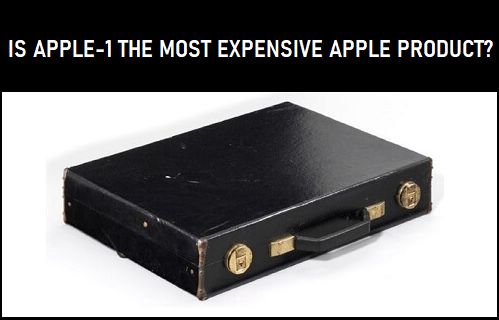Source: Christie’s of London
The Most Expensive Apple Product
According to Christie’s of London, Apple’s first computer (Apple-1) was sold to an anonymous buyer for GBP 371,250 ($459,000), in an online auction conducted during 16-23, May 2019. The computer was previously owned by Rick Conte, who bought it in 1977 to learn BASIC and later donated the computer to Maine Personal Computer Museum in 2009. Originally priced at $666.66, Apple-1 computers were hand-built by Apple founders Steve Jobs and Steve Wozniak and launched in 1976. The auctioned computer is one of the few rare functioning Apple-1 computers that currently exist in the world.
The Highest Price Paid for Apple-1 Computer is $905,000
According to Christie’s website, they had earlier auctioned an Apple-1 computer signed by Apple co-founder Steve Wozniak for $387,750 in 2013. The latest listing (July 2 2020) for an Apple-1 computer sold for $458,711.25 is available at RR Auctions. However, the highest price paid for an Apple-1 computer is $905,000, by Henry Ford Museum, Dearborn, Michigan on 22 October 2014. The highest individual price paid for an Apple-1 computer is $815,000, paid by Shannon and Glenn Dellimore, co-founders of popular skincare line Glamglow.
How Many Apple-1 Computers Exist in the World
Out of 200 Apple-1 computers sold, only 15 are currently known to be held in public collections by museums dedicated to science and technology around the world. Encouraged by the success of Apple-1, Jobs and Wozniak launched Apple-2 in 1977, which continued to remained in production and improvements until 1993. Apple-1 was discontinued in October 1977, with Jobs & Wozniak encouraging owners to return their machines for trade-ins and discounts. The returned Apple-1 computers were destroyed, which explains why only a few Apple-1 computer survived and fewer exist in working condition.
Apple-1 Computer Specs & Features
Apple-1 computer was basically a motherboard, it did not even have a Keyboard or a monitor to connect to. In order to make a working computer, the users had to add a case, power supply transformer, power switch, keyboard and a monitor (a television set).
Source: Wikipedia Apple-1 came with 4Kb dynamic random access memory (DRAM) which could be expanded to 8Kb on-board and to 64kb externally. By current standards, 8kb is not even good enough to store a single iTunes song and you can easily find USB Drives with 1TB storage capacity. However, in those days 8kb was extraordinary, as most computers in that price range included just 1Kb Static Memory (SRAM). Another innovation was the built-in video terminal, which allowed users to view their commands in real time by connecting Apple-1 to television screen or video monitor. In comparison, competing models like ASR-33 Teletype could only print output to spools of paper.
How to Cast Chrome Browser to TV From iPhone or iPad How to Make Free Calls On iPhone Using WhatsApp

